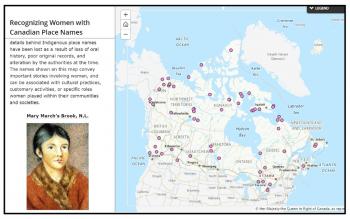Summary
Local Journalism Initiative Reporter
Windspeaker.com
As the Geographical Names Board of Canada (GNBC) was creating its newest interactive map, it asked the provinces and territories to provide sample lists of geographical sites named for women.
More than 10 per cent of those names were for Indigenous women.
“I was pleasantly surprised at the number of Indigenous names there were in that sample because, from what I understand, the tradition in Indigenous naming is not to name a place for a particular person – I’m basing this on the research my team has done – but for use of the land,” said Steve Westley, manager, GNBC Secretariat, with the Canada Centre for Mapping and Earth Observation at Natural Resources Canada.
“The names tell such an interesting story across the country on how Indigenous women interact and use the land, we believed that a special category would visually show that on the map,” he said.
Women of Indigenous Cultures is one of nine categories selected for the map entitled “Recognizing Women with Canadian Place Names” that marks 500 locations.
It is an important category to include, says Janice Sharpe, senior director with the Canada Centre for Mapping and Earth Observation, and shows one of the many ways women have impacted our country.
“What was really surprising about this (map) … is just the diversity of place names that are named for women. In some cases, they’re very local. They’re a family member, just a person who lives in that community. In other places they’re women who really made a mark for women in Canada,” said Sharpe.
Provinces and territories were asked to send a sample of the women’s names that covered their geographic jurisdiction and also represented the diversity of women in the roles they were engaged in and the occupations they held, says Westley.
Indigenous women have also been included in some of the other eight categories for the new map, such as community service and the arts.
The interactive map has six different layers. The first layer is all 500 place names in all nine categories. The Indigenous women’s names are marked with purple dots. The second map shows only the Indigenous women place names.
“You can zoom around the country, click on a dot and a piece of information comes up, a picture and paragraph on the woman,” said Sharpe. “It’s a really interesting piece and I would highly recommend people explore it.”
More names can be added to the map although a procedure and strict criteria must be followed.
GNBC has never established a subset to determine the split between geography named for males and females, says Westley.
There is a disparity, says Sharpe, “that’s historical and cultural.”
That disparity is partially because settlers, surveyors, explorers, geologists and postmasters, who were predominantly men, named the geographical features; and the GNBC board was comprised only of men until the 1960s. The board had its first woman chair in 1999 and it is now being led by a woman.
“We’re in constant touch with the provinces and territories and we’re fully prepared to update our maps, update our databases with the most up-to-date Indigenous names,” said Westley.
The GNBC has a database of about 300,000 geographical names, and about 30,000 of those place names could be Indigenous in origin.
“Indigenous naming has been a major focus of our board for at least a decade now,” said Westley. “There’s such a rich and important history that we want to bring forward here on how geographical names reinforce and illustrate Indigenous cultures and languages across the country… It’s right there in front of us but it’s not always obvious until you look at something like a map.”
GNBC recently appointed its first Indigenous advisor in Ava Hill, former chief of the Six Nations of the Grand River, and is presently looking to appoint Inuit and Métis advisors as well.
“The board is super interested in hearing about Indigenous names right across the country from coast to coast to coast. There’s an interest in researching and understanding and adopting more official Indigenous names,” said Westley.
Marking these Indigenous place names on a map strengthens Indigenous language and culture and is a response by GNBC to both the United Nations Declaration on the Rights of Indigenous Peoples and Calls to Action from the Truth and Reconciliation Commission of Canada, points out Westley.
But even more than that, he says, “these names are everywhere. The name of the country is Indigenous in origin. The names of several of the provinces are Indigenous in origin. Our major cities are Indigenous in origin. But nobody seems to realize that…. The stories are so important for everyone to understand where these names originate from.”
“Recognizing Women with Canadian Place Names” interactive map is available at: https://maps.canada.ca/journal/content-en.html?lang=en&appid=2b110593983a45159b839e28a8b5d839&appidalt=0a2ad7222d6a4b98a3beb7c651821b3e&utm_campaign=nrcan-rncan-womens-map&utm_medium=vurl&utm_source=canada-ca-womens-map&fbclid=IwAR03q6uADMkmH0iFPRPQnzm3xq5ITYJ_0Py8leFi1UtDaJJCL6U6fjlD4K0
Local Journalism Initiative Reporters are supported by a financial contribution made by the Government of Canada.

